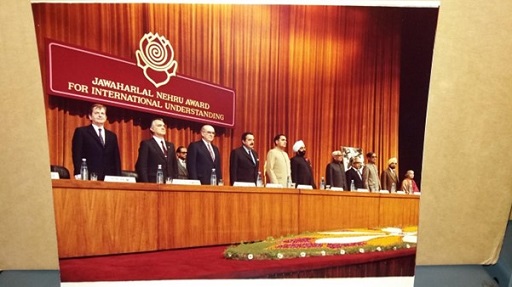2 Government cooperation with anti-nuclear activists
While the UK government had an adversarial relationship with anti-nuclear activists, this was by no means the case in all countries. In some cases, activists and civil society groups cooperated fruitfully with policymakers and governments, resulting in new policies and even international initiatives for nuclear disarmament.
One example is the Six Nation Initiative (also known as the Five Continent Initiative). On 22 May 1984, against the backdrop of the nuclear arms race and heightened tensions between the United States and the Soviet Union, six world leaders came together to call for concrete measures to reduce tensions and nuclear weapons. Raúl Alfonsín of Argentina, Indira Gandhi of India, Miguel de la Madrid of Mexico, Julius Nyerere of Tanzania, Olof Palme of Sweden, and Andreas Papandreou of Greece made the following proposal:
We urge, as a necessary first step, the United States and the Soviet Union, as well as the United Kingdom, France and China, to halt all testing, production and deployment of nuclear weapons and their delivery systems, to be immediately followed by substantial reductions in nuclear forces … This first step must be followed by a continuing programme of arms reductions leading to general and complete disarmament … The essential goal must be to reduce and then eliminate the risk of war between nations.
The initiative originated among a group of anti-nuclear activists including New Zealander Nicholas Dunlop, Canadian Douglas Roche, and Icelandic MP Ólafur Ragnar Grímsson. Keen to work across national boundaries and to have activists and politicians work together, they approached several world leaders to take part in the initiative, with six ultimately agreeing by the spring of 1984.

Activity 2
Watch this video of then President of Argentina Raúl Alfonsín accepting a peace award for the 1984 Six Nation Initiative, then answer the question below.

Transcript
[APPLAUSE]
[APPLAUSE]
- According to President Alfonsín, how can the leaders of six non-nuclear countries influence the governments of nuclear-weapons states towards disarmament?
Discussion
- Alfonsín argues that he and the other five national leaders have reason on their side. Moreover, he suggests that their voices are joined by those of hundreds of millions, referring to the importance of citizens around the world calling for nuclear disarmament.
While the Six Nation Initiative did not immediately succeed in bringing about a nuclear freeze or securing general disarmament, it was nevertheless an important example of world leaders from different parts of the world cooperating with other each and with anti-nuclear activists from around the world to push for nuclear disarmament.
